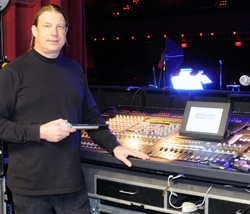
One rental PM5D was so old that years of reaching under the first row of Mix output XLRs to re-patch the lower rows had caused them to degenerate to a partial “cold solder” state with the accompanying buzzes, but this problem was easily solved by copying all eight troubled outputs to the matrix that day.
Our wireless in-ear monitors were Sennheiser ew300 G2 systems, which are a great value. However, unlike the 100 milliwatt output of their dual channel 350 G2 siblings, the half-rack format 300’s only provide 20 milliwatts, so frequency selection and antenna type and placement are of paramount importance.
The inverse square law applies, so halving the distance from transmitter to receiver quadruples the power, same as with audio frequencies. My personal helical saved me countless times, but a well placed paddle is often sufficient in moderate RF environments.
The biggest RF problems in country music often happen at state fairs, where it’s every sheep for himself. (And television appearances in Times Square can be saved for another article.)
Sennheiser provides a couple of great online resources (www.sennheiserusa.com). First, Frequency Finder charts for major metropolitan areas are good guides for visualizing local TV broadcast frequencies that can cause trouble. Second, the “Find Frequencies” application on the company website under the “Service” menu is also helpful to predict specific signal strengths.
The best tool, however, is the scanning ability built into the EK 300 belt-packs, which make it possible to find open frequencies without the aid of a scanner. Simply scanning each of the eight pre-programmed frequency groups, the group with the highest number of open frequencies provides the best solution.
Challenging urban RF environments are best served by finding the group with the greatest number clear channels, as each group spreads them out differently across their range of six TV stations.
Simpson’s vocal mic is a Sennheiser MK 5200 handheld wireless with a Neumann 105 capsule, in the “champagne” nickel finish. The new Sennheiser em3732 dual-channel receiver uses DSP-based HiDyn plus expansion and it honestly sounds as good as a hard-wired mic.
If you test this newest Sennheiser wireless alongside a 5000 handheld with an older receiver, you’ll think the 5000 must be broken. Further, there’s an AES output to patch into a digital console and bypass the console’s mic-pres and AD conversion.
The best feature is the beautifully redesigned icon-based front panel interface. Also, both audio output and mic sensitivity can now be adjusted in increments of 1 dB. I can’t wait until Sennheiser’s new e965 “true condenser” capsule is available for the 5200. Anyone investing in high-end wireless concert mics in next year should audition this combination.

Besides the files for our PM5Ds, we carried a lightweight four-space Hardigg ProRack that weighs 65 pounds loaded with three Sennheiser ew300 G2 in-ear transmitters, a Sennheiser 3732 receiver for Jessica’s wireless mic and an Apogee Big Ben digital word clock. The “shark fin” antennas for the transmitters and receiver stow nicely in the back.
A Pelican 1610 with a divider insert organizes all the small, loose items: Several bricks of batteries, six RF IEM packs and a hardwire pack, plus the two handhelds, Jessica’s UE 5 and a spare set. I also carry all the musicians’ generic ear buds, plus a set of generics as spares for every musician who carries their own custom molds with them.
